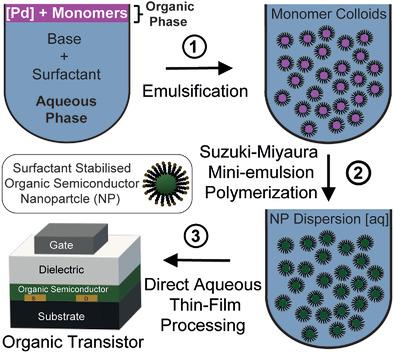Our official English website, www.x-mol.net, welcomes your
feedback! (Note: you will need to create a separate account there.)
Organic Semiconductors Processed from Synthesis‐to‐Device in Water
Advanced Science ( IF 14.3 ) Pub Date : 2020-09-21 , DOI: 10.1002/advs.202002010 Aiman Rahmanudin 1 , Raymundo Marcial-Hernandez 1 , Adibah Zamhuri 1 , Alex S Walton 2 , Daniel J Tate 1 , Raja U Khan 1 , Suphaluk Aphichatpanichakul 1 , Andrew B Foster 1 , Sebastian Broll 1 , Michael L Turner 1
Advanced Science ( IF 14.3 ) Pub Date : 2020-09-21 , DOI: 10.1002/advs.202002010 Aiman Rahmanudin 1 , Raymundo Marcial-Hernandez 1 , Adibah Zamhuri 1 , Alex S Walton 2 , Daniel J Tate 1 , Raja U Khan 1 , Suphaluk Aphichatpanichakul 1 , Andrew B Foster 1 , Sebastian Broll 1 , Michael L Turner 1
Affiliation

|
Organic semiconductors (OSCs) promise to deliver next‐generation electronic and energy devices that are flexible, scalable and printable. Unfortunately, realizing this opportunity is hampered by increasing concerns about the use of volatile organic compounds (VOCs), particularly toxic halogenated solvents that are detrimental to the environment and human health. Here, a cradle‐to‐grave process is reported to achieve high performance p‐ and n‐type OSC devices based on indacenodithiophene and diketopyrrolopyrrole semiconducting polymers that utilizes aqueous‐processes, fewer steps, lower reaction temperatures, a significant reduction in VOCs (>99%) and avoids all halogenated solvents. The process involves an aqueous mini‐emulsion polymerization that generates a surfactant‐stabilized aqueous dispersion of OSC nanoparticles at sufficient concentration to permit direct aqueous processing into thin films for use in organic field‐effect transistors. Promisingly, the performance of these devices is comparable to those prepared using conventional synthesis and processing procedures optimized for large amounts of VOCs and halogenated solvents. Ultimately, the holistic approach reported addresses the environmental issues and enables a viable guideline for the delivery of future OSC devices using only aqueous media for synthesis, purification and thin‐film processing.
中文翻译:

有机半导体在水中从合成到器件的加工
有机半导体 (OSC) 有望提供灵活、可扩展和可打印的下一代电子和能源设备。不幸的是,人们越来越担心使用挥发性有机化合物(VOC),特别是对环境和人类健康有害的有毒卤化溶剂,从而阻碍了实现这一机会。据报道,一种从摇篮到坟墓的工艺可实现基于茚并二噻吩和二酮吡咯并吡咯半导体聚合物的高性能 p 型和 n 型 OSC 器件,该器件利用水相工艺,步骤更少,反应温度更低,VOC 显着减少(> 99%)并避免所有卤化溶剂。该过程涉及水性微乳液聚合,产生足够浓度的表面活性剂稳定的 OSC 纳米粒子水分散体,以便直接水性加工成用于有机场效应晶体管的薄膜。令人鼓舞的是,这些器件的性能可与使用针对大量 VOC 和卤化溶剂优化的传统合成和加工程序制备的器件相媲美。最终,报告的整体方法解决了环境问题,并为仅使用水介质进行合成、纯化和薄膜处理的未来 OSC 设备的交付提供了可行的指南。
更新日期:2020-11-04
中文翻译:

有机半导体在水中从合成到器件的加工
有机半导体 (OSC) 有望提供灵活、可扩展和可打印的下一代电子和能源设备。不幸的是,人们越来越担心使用挥发性有机化合物(VOC),特别是对环境和人类健康有害的有毒卤化溶剂,从而阻碍了实现这一机会。据报道,一种从摇篮到坟墓的工艺可实现基于茚并二噻吩和二酮吡咯并吡咯半导体聚合物的高性能 p 型和 n 型 OSC 器件,该器件利用水相工艺,步骤更少,反应温度更低,VOC 显着减少(> 99%)并避免所有卤化溶剂。该过程涉及水性微乳液聚合,产生足够浓度的表面活性剂稳定的 OSC 纳米粒子水分散体,以便直接水性加工成用于有机场效应晶体管的薄膜。令人鼓舞的是,这些器件的性能可与使用针对大量 VOC 和卤化溶剂优化的传统合成和加工程序制备的器件相媲美。最终,报告的整体方法解决了环境问题,并为仅使用水介质进行合成、纯化和薄膜处理的未来 OSC 设备的交付提供了可行的指南。











































 京公网安备 11010802027423号
京公网安备 11010802027423号